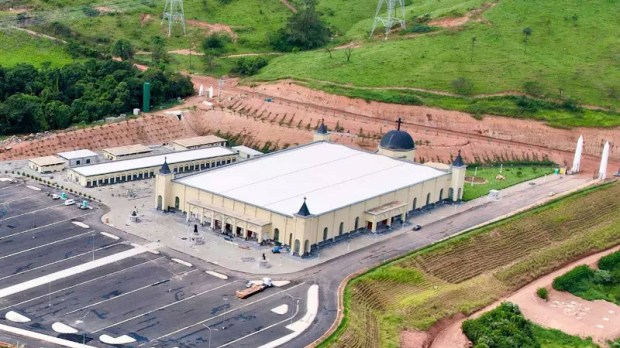As of May 22 of this year, St. Rita of Cascia has a new shrine in Brazil, and it’s bigger than any other structure dedicated to the Italian “saint of impossible causes” anywhere in the world.
Who’s behind it? Neither the diocese, nor a religious community; it’s Paulo Flavio de Melo Carvalho, who is 74 years old and a successful entrepreneur. Born in Cássia, a city of 18 thousand inhabitants in the south of the state of Minas Gerais, Brazil, he owns companies in the real estate, pharmaceutical, and packaging sectors, with operations in several states in Brazil and abroad.
In an interview with the local press, the businessman revealed that he is very devoted to St. Rita of Cascia—a devotion he inherited from his mother. He said, “My mother was very devoted to St. Rita. She prayed the Rosary and became a great friend of St. Rita. I admired her for this devotion. So, I got used to it and St. Rita became my favorite saint, together with Our Lady of Aparecida and Jesus.”
The shrine’s Facebook page shows the church filled to the brim as the local bishop, José Lanza Neto of the diocese of Guaxupé, blessed the faithful during the shrine’s consecration.
The idea of honoring the saint of impossible causes came up in the context of a promise (which the businessman calls an “exchange”). “I wanted to leave a legacy to the planet when I turned 60 years old, but I didn’t know what kind; that idea kept nudging me in my head. That’s when I thought, ‘I’m very devoted to St. Rita, so I’ll make a shrine for her.’ But I made an exchange with the saint. I said, ‘If I reach the age of 60 and am healthy, I’ll build a shrine.’ And this ended up happening,” reveals Paulo Flávio.
From this “exchange” came the world’s largest shrine dedicated to St. Rita of Cascia, located in the businessman’s hometown (named after the place where the saint lived and died as an Augustinian nun). At the beginning, though, he had no idea of the size of the undertaking he was dealing with. The finished shrine includes about 1,070,000 square feet of construction with the capacity to receive 7,000 people (5,000 seated).
“I didn’t know the size of the shrine I was going to build. So I bought the land and then we went on to realize that what I wanted to do was a gigantic undertaking, like few others in the world,” he said.
At the inauguration, Bishop José Lanza Neto, the local ordinary, said, “May this space be a place of encounter for those who seek the renewal and intensification of the Christian faith and that of their family,” reports Agência Minas. The news agency adds that the shrine complex includes a replica of St. Rita’s house, a food court, and stores selling religious items for pilgrims.
The new shrine is presented on its website essentially as a remote extension (not a replacement) of the city’s earlier shrine and parish dedicated to St. Rita, a beautiful church inaugurated in 1943. The first chapel dedicated to St. Rita in the region, no longer extant, was built back in 1846 according to the website.
The shrine and the economy
The investment that went into building the shrine is estimated at around 5.23 million dollars. The complex was donated by the businessman to the local diocese, which will be responsible for its administration.
The hope is that the shrine, besides being a holy site that fosters prayer and devotion to St. Rita, will also help boost the city’s economy and religious tourism.
“I could very well, with this money, open a company and create 500 jobs here in the city, but the shrine can provide jobs for five or six thousand people. It will be a gigantic movement in the city, which will give sustainability to the city and to those who want to be able to earn a living,” said the businessman. According to Agência Minas, Minas Gerais is the Brazilian state which receives the greatest amount of religious travel in the country.
Paulo Flávio also revealed that he has already made another “exchange” with St. Rita of Cascia, but it will only be revealed when the businessman turns 80 years old.



